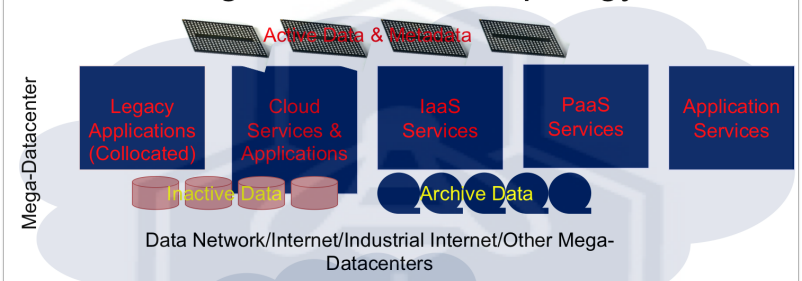 NEWS
NEWS
 NEWS
NEWS
 NEWS
NEWS
IBM’s massive nine-figure contract to help Columbia Pipeline Group Inc. upgrade its infrastructure and internal employee support operations over a five-year period is symbolic of a bigger transformation outlined by Wikibon cofounder David Floyer (below) in a concept he calls the “mega-data center.” Floyer first articulated this vision a year ago and recently updated it on Wikibon.com.
![]() While the size of the IBM deal is nothing out of the ordinary, the structure aligns to Floyer’s vision. IBM will move Columbia Pipeline’s IT infrastructure and business applications from the energy firm’s on-premise data centers to a private cloud in an IBM data center in Columbus, Ohio. As Floyer sees it, this is an example of what will become the dominant model for infrastructure deployment over the next decade. “The traditional data center as we know it, for most organizations, will not exist within 10 years, even in the largest enterprises of the world,” he writes
While the size of the IBM deal is nothing out of the ordinary, the structure aligns to Floyer’s vision. IBM will move Columbia Pipeline’s IT infrastructure and business applications from the energy firm’s on-premise data centers to a private cloud in an IBM data center in Columbus, Ohio. As Floyer sees it, this is an example of what will become the dominant model for infrastructure deployment over the next decade. “The traditional data center as we know it, for most organizations, will not exist within 10 years, even in the largest enterprises of the world,” he writes
Replacing it will be massive virtualized server farms that will run at half the cost of on-premise infrastructure while providing superior scalability, reliability and, yes, even security compared to traditional data centers.
Underlying this concept is what Floyer sees as a shift in IT’s value away from infrastructure and toward data. In essence, IT is too precious a resource to waste on tending machines. On-premise computing has been a necessary evil until now, he asserts, but the “as-a-service” revolution, combined with open-source software and high-speed communications, changes the rules. The prediction often (and incorrectly) attributed to former IBM CEO Thomas J. Watson that “there is a world market for maybe five computers” may turn out not to have been far off-base.
One of the technology developments underpinning this trend is high-speed flash storage, the cost of which is dropping like a rock. The scalability and simplicity of flash storage will stoke the development of what Wikibon calls Server SANs. In essence, storage will move off of disk farms and closer to the computers that need it, creating the opportunity to apply multiple processors to shared storage in order to mine large databases at very high speed.
|
The prediction…that “there is a world market for maybe five computers” may turn out not to have been far off-base. |
Server SANs are a key component of software-led infrastructure, a technology shift that itself will enable mega-data center providers to provision and manage resources with unprecedented flexibility. The platform is likely to be a combination of open hardware stacks, such as the Open Compute Project, and open software stacks such as OpenStack. Even environmental services like power, cooling and lighting will be automated and controlled by a master “Cloud OS.” Floyer dismisses oft-cited security worries as overblown. “Mega-data centers could provide at least equal and probably better overall security than in-house” operations, he writes.
The cost of IT infrastructure provisioned in this way will be half or less of what it is today. “This will enable mega-data center services to be formidable competitors to cloud service providers such as Amazon Web Services and traditional system vendors such as HP, IBM and Oracle,” he writes.
Mega-data centers won’t be cloud computing services as we think of them today, although there’s no reason cloud service providers can’t participate in the market. Each customer will essentially run its own virtual data center within the providers for walls. These new-age facilities will not only host and serve new applications but will also house legacy hardware and software imported from customer facilities.
That’s a key differentiator, because Floyer believes a strategy of migrating all legacy systems to cloud platforms is foolhardy. “So-called legacy applications usually work well, and converting them to run in the cloud is a risky and usually unnecessary strategy,”’ he writes. “The easiest way to bring legacy applications forward is to collocate the data in the same mega-center that houses the new home-grown and cloud applications.”
But make no mistake, he adds, “Wikibon recommends that organizations should keep what remains in the enterprise IT control centers to a minimum.”
The ultimate winner in this totally outsourced IT environment is, in fact, IT. Tech organizations have struggled for years to contribute more value to the bottom line, but had been shackled by the overhead of maintenance. The arrival of Big Data analytics presents the opportunity for IT to significantly impact the business, but the amount of data that will need to be processed “will be many times the size of enterprise data. If a traditional data center approach is taken, it will require increasingly massive data movement either to or from the enterprise data center,” Floyer states.
The only way to take advantage of the coming Big Data explosion is by moving data and processing power off-site. CIOs should focus on designing their systems to take advantage of this transformative opportunity, and leave the backups and air-conditioning to the experts. “The focus of IT should move to positioning the enterprise to exploit the data avalanche from the Internet and industrial Internet, and enable real-time analytics,” Floyer concludes.
Read Floyer’s full report on Wikibon.org.
THANK YOU